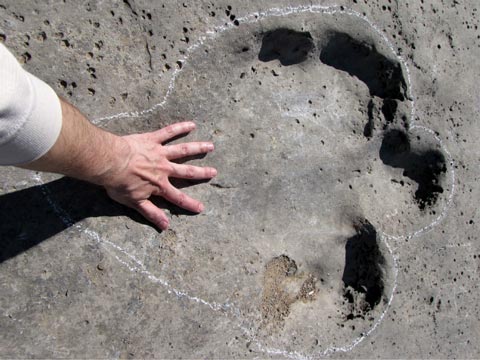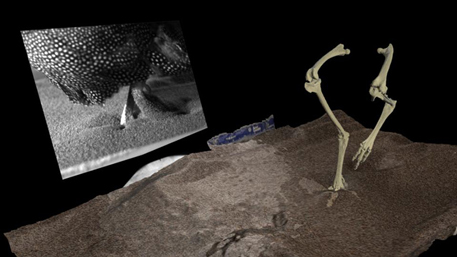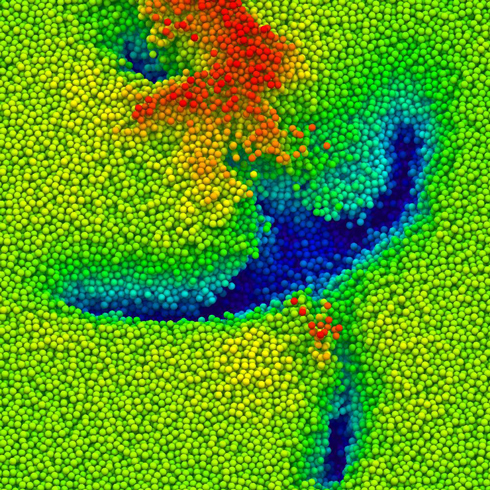Walking with Dinosaurs – Birth of a Dinosaur Footprint
Getting Under the Skin of a Dinosaur’s Foot
The footprints of prehistoric animals preserved as fossils can provide scientists with a wealth of information. However, in a research project involving Brown University (Providence, Rhode Island) and the Royal Veterinary College, steps have been taken (no pun intended), to get a much more complete understanding of how ancient creatures walked. It’s question of applying a number of highly technical research methods to step into the footsteps of a dinosaur, this research certainly adds a whole new meaning to “Walking with Dinosaurs”.
Walking with Dinosaurs
Providing a Deeper Understanding About Fossil Footprints
Picture credit: AFP Photo/Igor Sasin
Dinosaur Footprint
Dr Peter Falkingham, a Research Fellow at the Royal Veterinary College (London) and co-author, Professor Stephen Gatesy (Brown University), attempted to map the displacement and complex re-organisation of sediment that takes place when a footprint is formed. Put simply, imagine you are walking on the beach, across wet sand. As you proceed across the sediment you will create footprints, these are visible impressions left in the surface layer, however, as your bodyweight moves across the sand, it will have an impact on the sand particles that surround and are underneath the area that you have just walked over. In a unique experiment, the scientists have been able to create visual images of the re-organisation of particles involved in footprint formation.
This research can help ichnologists (the term used to describe a specialist in studying trace fossils), interpret dinosaur footprints, thus in turn providing palaeontologists with a better understanding of prehistoric animal locomotion.
A Variety of Research Techniques Employed
A variety of techniques were used to create visual images of three-dimensional footprints. Firstly, a guineafowl (Galliformes) was persuaded to walk across a bed of poppy seeds. The poppy seeds and the way that they were moved would mimic the action of the substrate as if it were soft sand. The virtual footprint was created by combining two X-ray videos with a digital skeletal model of the bird’s legs derived from CT scans and a three-dimensional motion analysis called X-ray Reconstruction and Moving Morphology (XROMM), which had been developed at Brown University.
This technology enabled the research team to reconstruct the motions of the bird’s foot in three dimensions, even when the toes are hidden from sight as they sink into the sediment.
Which Came First the Guineafowl or the Virtual Simulation of a Dinosaur Footprint?
Picture credit: Royal Veterinary College/Brown University
The picture above shows the hind limb bones of the guineafowl, projected in three dimensions along with the footprints formed.
“Ground-breaking” Research
Commenting on this ground-breaking research (literally), Dr Falkingham stated:
“By observing how a footprint is formed, from the moment the foot hits the sediment until it leaves, we can directly associate motions with features left behind in the track. We can then study a fossil track left by a dinosaur and say, OK, these features of the track are similar, but these are different, so what does that mean for the way the animal was walking?”
A powerful computer programme was used to analyse and interpret the data, so that a virtual footprint that had been generated could be observed as an impression at the surface and also below the surface of the substrate. Being able to directly associate movements of the foot with features of the footprint, both on the surface and deeper into the sediment, opens up the possibility of more accurately reconstructing the way in which long extinct creatures moved.
The Simulated Footprint (Guineafowl Footprint)
Picture credit: Royal Veterinary College/Brown University
Professor Gatesy added:
“Footprints are not just simple moulds of the bottom of the foot, so it’s important to understand how the dynamic interaction between a living animal and the substrate give rise to a track’s 3-D shape”.
The team’s findings, published in the journal “Proceedings of the National Academy of Sciences”, could help palaeontologists better understand how dinosaurs walked and perhaps build up a picture of how dinosaur locomotion changed as the Dinosauria evolved. Moving forward, (again no pun intended), the advent of XROMM technology could help researchers explore how early hominids adapted to a bipedal stance.
Visit Everything Dinosaur’s website: Dinosaur Models, Toys and Gifts.




